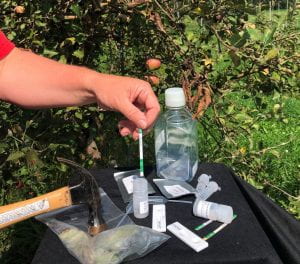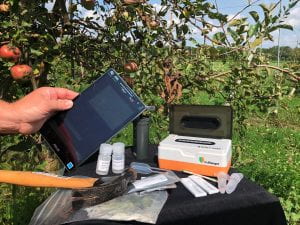Rapid pathogen detection in the orchard can help timely diagnosis and identification of sources of inoculum to help deploy appropriate fire blight control measures and contain pathogen spread to further tissues, or significant damage. Fire blight symptoms in shoots can be confused with nectria twig blight or spray damage, while infected tree suckers and water-sprouts can be misdiagnosed with spray damage, leading to rootstock blight. Lateral flow Immuno-assay kits can be used for testing symptomatic tissue to confirm presence of E. amylovora when there are uncertainties between spray damage, nectria, and fire blight infection. The Loop Mediated Isothermal Amplification (LAMP) based pathogen detection is a simple and cost-effective method that relies on specific set of DNA primers to amplify and detect target pathogen genes in 15-60 minutes (Buhlmann et al. 2013; Kubota et al. 2015). This assay can also be used to monitor asymptomatic progress of fire blight infection, but needs to be optimized for precision, sensitivity, speed, and cost (Notomi et al. 2015; Tomlinson, 2013). It is in use for citrus, tomato, potato, and grapes by growers and USDA-ARS for on-site detection of pathogens.
We have optimized the use of two commercially available immuno-kits and have tested a commercial battery-operated device for LAMP-based detection of fire blight. These detection methods can distinguish fire blight symptoms from other similar disorders and save growers the time it would take to send symptomatic tissue for diagnosis. We have developed optimized and simplified protocols to use LAMP assay and kits in apple orchards for fire blight detection. Please see more details in the extension article published in the New York Fruit Quarterly Fall 2019 Issue (Khan et al. 2019), and research article published in the Journal of Plant Pathology (Singh et al. 2020). Please see more details on use of the LAMP assay and kits in the interactive presentation guide, video demonstrations, and brochures below and write to us if there are questions.
Interactive presentation/video guide:
Click to browse our interactive guide to fire blight detection!

Video demonstrations:
Video 1: How to Rapidly Detect Fire Blight in the Apple and Pear Orchards (AgriStrip Kit).
Video 2: How to Rapidly Detect Fire Blight in the Apple and Pear Orchards (Pocket Diagnostics Kit).
Video 3: How to Rapidly Detect Fire Blight in the Apple and Pear Orchards or in the Disease Diagnostic Lab (LAMP Assay)?
Brochures:

Brochure1: Lateral flow Immuno AgriStrip Kit (Bioreba, Reinach, Switzerland)
 Brochure 2: Lateral flow Immuno Pocket Diagnostics Kit (Abingdon Health, York, UK)
Brochure 2: Lateral flow Immuno Pocket Diagnostics Kit (Abingdon Health, York, UK)
 Brochure 3: Loop Mediated Isothermal Amplification (LAMP) with ‘BioRanger’ Device (Diagenetix, Inc.)
Brochure 3: Loop Mediated Isothermal Amplification (LAMP) with ‘BioRanger’ Device (Diagenetix, Inc.)
References:
Khan MA, Cobb-Smith D, Higgins L, and Singh J. 2019. Pathogen detection assays for fire blight management in apple orchards. New York Fruit Quarterly, 27 (2), 27-30.
Singh J, Cobb-Smith D, Higgins E, Khan MA. 2020. Comparative evaluation of lateral flow immunoassays, LAMP, and quantitative PCR for diagnosis of fire blight in apple orchards. Journal of Plant Pathology, https://doi.org/10.1007/s42161-020-00644-w.
Buhlmann, A., Pothier, J., Rezzonico, F., Smits, T., Andreou, M., Boonham, N., Duffy, B., and Frey, J. 2013. Erwinia amylovora loop-mediated isothermal amplification (LAMP) assay for rapid pathogen detection and on-site diagnosis of fire blight. Journal of Microbiological Methods 92: 332-339.
Kubota, Ryo and Daniel M. Jenkins. 2015 Mar. Real-Time Duplex Applications of Loop-Mediated Amplification (LAMP) by Assimilating Probes. Int J Mol Sci. 16(3): 4786–4799.
Notomi, T., Mori, Y., Tomita, N., and Kanda, H. 2015. Loop-mediated isothermal amplification (LAMP): principle, features, and future prospects. Journal of Microbiology 53(1): 1-5.
Tomlinson, Jenny. (2013). In-Field Diagnostics Using Loop-Mediated Isothermal Amplification. Methods in molecular biology (Clifton, N.J.). 938. 291-300. 10.1007/978-1-62703-089-2_25.